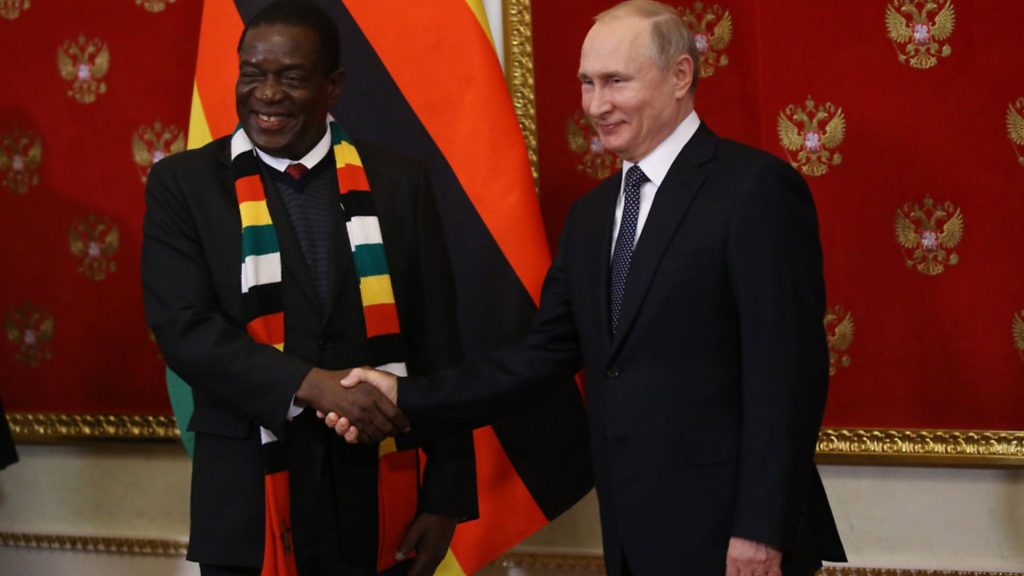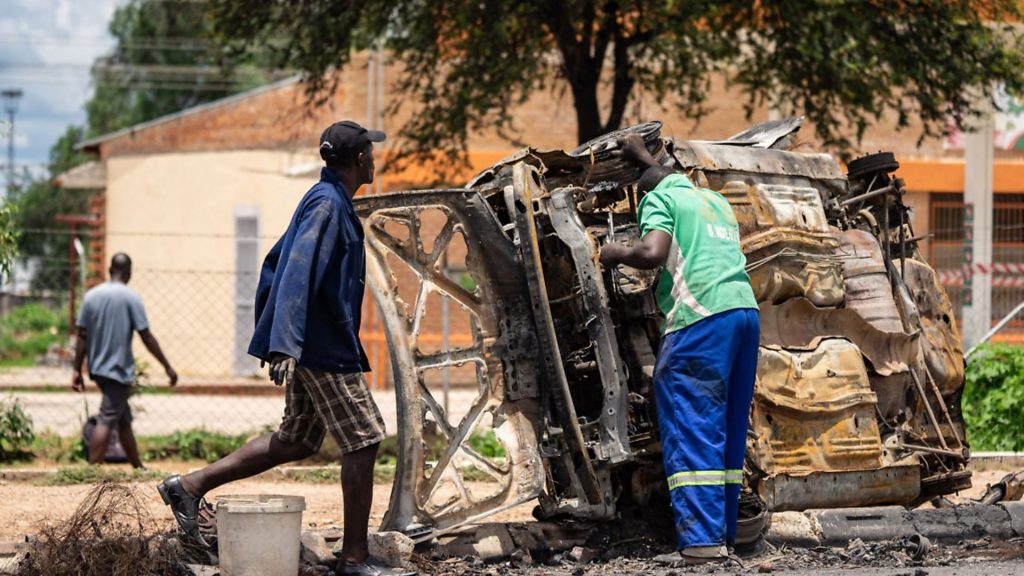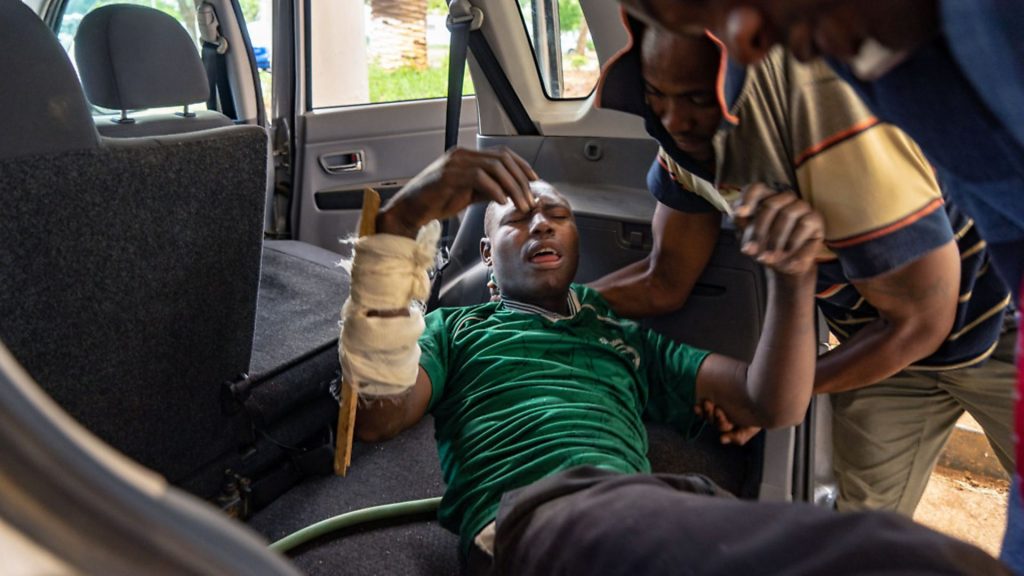
PAUL KNOTT on the descent of Zimbabwe into chaos and violence – and how the warning signs were there all along.

‘The matter is out of our control,’ said an ominous text from Zimbabwe’s leading communications provider, Econet, to its users on January 15.
The message announced a shutdown of the internet on the orders of the office of president Emmerson Mnangagwa. The day before, his government had deployed the military to snuff out mounting protests across the country sparked by a sharp rise in the price of fuel. By closing down the social media networks, the security forces could – in the words of Zimbabwean human rights lawyer Doug Coltart – ‘unleash a campaign of terror’ against the protestors ‘under cover of an internet blackout’.
Despite the government’s attempt to hide its actions, details of horrific attacks by the security forces on unarmed civilians emerged, as well as gruesome images appearing to show the beaten and bloodied bodies of some of those caught up in the violence.
Reporting in the independent Zimbabwean newspaper Newsday corroborates the stories of security force excesses. It describes a hospital in Harare with ‘the waiting room and corridors packed with victims’. These include people who have had their eyes gouged and beaten with motorcycle chains and iron bars.

The information blackout and mass arrest of opposition and independent NGO activists makes precise casualty figures hard to establish. But on only the second day of the government’s violent crackdown Zimbabwe’s Association of Doctors for Human Rights was already reporting ‘hundreds shot, tens dead’.
The Zimbabwe Human Rights NGO Forum has documented ‘at least 242’ further cases of ‘assault, torture, inhumane and degrading treatment, including dog bites’.
The widespread protests began in response to president Mnangagwa’s announcement, on January 12, of a 200% hike in the price of fuel. This raised the cost to $3.31 a litre – the highest petrol price in the world and completely unaffordable to most people in this impoverished country.
The knock-on effects on transport costs and prices of everyday goods creates intolerable pressure on a population that has been struggling for years to survive. Piers Pigou of the International Crisis Group, an NGO, reports that anger against the government has been building for some time. By December, ‘prices were already soaring, retailers were closing down and queues for petrol lengthening,’ he said.

The ruling ZANU-PF party controls Zimbabwe’s fuel supply. According to Pigou ‘the huge financial benefits that come with this are reportedly causing factional rivalry. There is widespread speculation that the shortages are caused by inter-elite squabbles or even deliberately engineered’.
Popular discontent is exacerbated by the fact that the decision to raise the fuel price has been taken in order to tackle a currency crisis created by government mismanagement.
Corrupt manipulation of the currency and exchange system has done great damage to the grim economic situation of ordinary Zimbabweans. It has increased the cost of essential imported goods and reduced the already meagre incomes of the many who rely on subsidies from family members who have fled the country.
Public fury was the inevitable result. The first step was a three-day general strike called by the Zimbabwe Congress of Trade Unions and supported by a broad range of civil society organisations.
More spontaneous demonstrations soon sprang up. These have been at their fiercest in the poorer districts of the two biggest cities, the opposition strongholds of Harare and Bulawayo. But they have also spread to other cities across the country.
In some instances, according to Human Rights Watch, the protests degenerated into vandalism and looting. This does not excuse the disgracefully disproportionate and violent response by the authorities.
Tragically, this latest chapter in Zimbabwe’s decades-long disintegration comes soon after the country was swept by optimism that change had come at last. The apparently immovable 93-year-old president Robert Mugabe was finally dislodged by a military coup in November 2017 and quickly replaced by Mnangagwa, his vice president, confirmed in office following a flawed election in July 2018.
The then British foreign secretary, Boris Johnson, was among those quick to hail the ‘impressive progress’ made during Mnangagwa’s first 150 days in office. Johnson’s Zimbabwean counterpart, Sibusiso Moyo, reciprocated by indulging Johnson’s ‘Empire 2.0’ fantasies, saying that ‘what Britain has lost with Brexit, they can recover from Zimbabwe’. Sadly, such optimism elevated hope above reality. Many Zimbabweans were soon describing Mnangagwa as merely ‘a new driver in an old taxi’.
Mnangagwa was a senior member of Mugabe’s appalling government for many years. He played a part in creating the problems of crumbling infrastructure, huge debts, runaway inflation and unemployment that he inherited as president. Worse, Mnangagwa’s fingerprints are all over the atrocities committed during Mugabe’s decades of misrule.
The most notorious instance of this was the ‘Gukurahundi’ massacres of 1983-87. According to the respected International Association of Genocide Scholars, more than 20,000 people from the Ndebele ethnic group were murdered by the Zimbabwean army. The killings were orchestrated by Mugabe and his senior ZANU-PF henchmen. Their aim was to eliminate supporters of the rival ZAPU political party and spread terror across an area were those opponents were popular.
These murders in the Matabeleland region were directly carried out by the North Korean-trained 5th Brigade of the Army. But many informed observers believe Mnangagwa was heavily implicated. At the time, he was a powerful and influential minister for state security, with responsibility for directing the Central Intelligence Organisation, Zimbabwe’s secret police. It seems scarcely conceivable that such an operation could have been carried out without Mnangagwa’s knowledge and involvement, although he denies it.
Mnangagwa first acquired his nickname of ‘the crocodile’ because of his activities as a guerrilla during Zimbabwe’s war of independence. It stuck because of his post-independence political persona – that of a frequently smiling presence who thought nothing of consuming anyone who crossed his path.
Mnangagwa fell out of favour with Mugabe for a spell in the early 2000s, when his jockeying to succeed the ageing autocrat was deemed too brazen. He was brought back when Mugabe needed someone ruthless to lead his re-election campaign in 2008.
Internal and international pressure forced Mugabe to allow his Movement for Democratic Change (MDC) opponent, Morgan Tsvangirai, to run against him. This presented Mugabe with his toughest challenge yet. Tsvangirai won the first round but, in a highly controversial count, was deemed by the authorities to have fallen fractionally short of the 50% required to avoid a run-off.
Mnangagwa and his colleagues removed all restraints during the second-round campaign. A brutal campaign of violence was unleashed in MDC-supporting areas, compelling Tsvangirai to withdraw and leading to Mugabe being ‘re-elected’ unopposed.
Mnangagwa was rewarded with the role of minister of defence and later appointed minister of justice and first vice president to Mugabe. Given the background, no-one should be surprised that president Mnangagwa has failed to live up to the euphoria that greeted the fall of Mugabe. His promises to ‘open the country for business’ and reform the management of Zimbabwe’s economy for the benefit of its people are proving hollow.
The reactions of the security forces to the latest protests seem to have escalated further and faster into extreme violence than they did even under the old dictator.
One of the rare hospital patients willing to give his name to Newsday, 46-year-old Albert Taurai, thinks so. He suffered a broken spine and said: ‘I have seen both Mugabe and Mnangagwa. This is worse than Mugabe.’
It is hard to chart a positive outcome for Zimbabwe.
The ruling cliques seem entrenched. The government is labelling the protestors ‘terrorists’, indicating it has no intention of reining in the repression. Regional powers such as South Africa have long been reluctant to exert significant pressure on them to do so.
Meanwhile, the international actors who used to have the most leverage over Zimbabwe, the US and UK, are weakened and distracted by Trump and Brexit.
As a result, appeals for international support by Zimbabweans such as MDC MP, Chalton Hwende, who says ‘we are being butchered by soldiers in the townships’, are falling on deaf ears.
In a sign of the shifting global power dynamics, Mnangagwa left on an overseas trip straight after announcing the fuel price rise and was meeting that reliable backer of tyrannical rulers, Vladimir Putin, in Moscow, on the day the internet was shutdown.
Some analysts in Harare suggest Mnangagwa may be replicating a strategy learned from Mugabe – discretely giving the orders whilst contriving to be out of the country, in order to blame the dirty work on an over-zealous deputy.
Since returning home earlier this week, Mnangagwa has said that ‘violence or misconduct by our security forces is unacceptable’ and, if it is proven in an investigation, ‘heads will roll’. Rumours have also begun circulating of a rift with vice president Constantino Chiwenga.
The mass detention of opposition and civil society activists may damp down organised protests in the short-term. But with no end in sight to the spiralling costs and shortages of food, fuel and medicine, more demonstrations are inevitable sooner or later.
The funerals of those killed in the first wave of protests could be an immediate flashpoint. Conversely, locking up opposition organisers could backfire on the authorities.
Their absence leaves a vacuum to be filled by younger, more confrontational and less disciplined demonstrators, who feel they have little left to lose. Following the sickening abuses of recent weeks, one shudders to think about the bloodshed that could ensue when they encounter the security forces again.
Warning: Illegal string offset 'link_id' in /mnt/storage/stage/www/wp-includes/bookmark.php on line 357
Notice: Trying to get property 'link_id' of non-object in /mnt/storage/stage/www/wp-includes/bookmark.php on line 37






